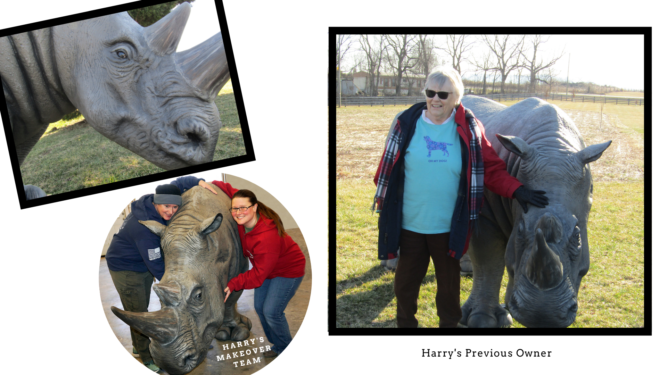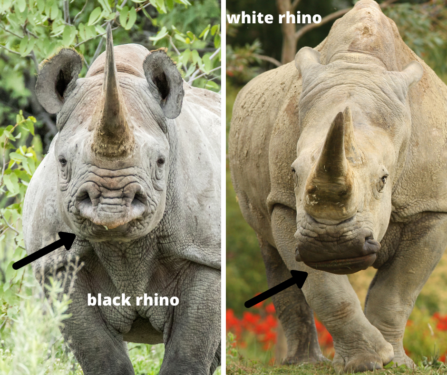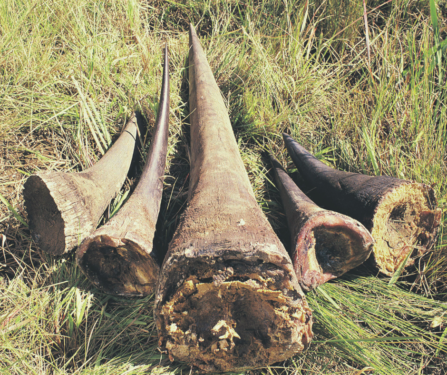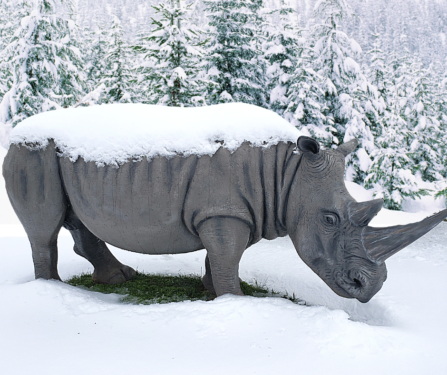Meet Harry the Black Rhino - National Humane Education Society
If you have had the pleasure of visiting the NHES campus, then you had a unique opportunity to see a life-size, black rhinoceros (rhino). This rhino statue is fondly referred to as Harry, or Hieronymus, by his previous owners—The Sweeney Family—who gifted him to NHES to raise awareness about the black rhino. After his arrival, he received a makeover by the talented staff of NHES and its animal care facility, The Briggs Animal Adoption Center.

Rhinos are one of the oldest mammals in the world. They enjoy solitary living but can be found in groups called “crashes.” Five species of rhinos call Asia and Africa home. The black rhino and the white rhino inhabit Africa, while the greater one-horned rhino, the Javan rhino, and the Sumatran rhino are found in Asia. In the wild, rhinos can live up to 50 years. The white rhino is the most populous of the species—numbering around 18,000—a stark contrast to the Javan rhino, which has dwindled to about 70. Sadly, the white rhino subspecies, the northern white rhino, has almost been obliterated—only two females remain in the world.
How Can You Tell Harry Is a Black Rhino?
At a glance, black rhinos and white rhinos look similar, so how can you tell the difference between them? You won’t be able to tell by their color—both are gray. The most distinguishable feature is in the shape of their upper lip—the black rhino has a pointed one, and the white rhino has a square one. This unique feature accommodates their herbivore diet by allowing the black rhino to grab leaves from trees, and the white rhino can easily graze.

What Fuels Humans to Kill Rhinos?

Rhinos emit strength and resilience with their large, armored bodies and foreboding horns. The only handicap they have is their poor eyesight. Their only predator is humans, who greedily kill them for their horns to use for medicinal purposes or as status symbols. Rhino horns are primarily composed of keratin, a protein also found in hair and fingernails. If they are removed carefully, they will grow back after three years.
Some seek its healing properties to cure ailments. A small study in Hong Kong revealed that traditional Chinese medicine (TCM) practitioners believe rhino horn has medicinal purposes but not as the sole source of treatment. It aids in decreasing a person’s core body temperature. The study also found that most Hong Kong residents prefer Western medicine to TCM. So, why is there still a demand for rhino horn?
According to this article (that was also highlighted by TRAFFIC, a wildlife trade monitoring network, in their 2012 report), several Vietnamese believe in the efficacy of rhino horn stating,
“I was diagnosed with stomach cancer nine years ago. I’ve tried everything including rhino horn powder every day. Now, doctors have told me I’m in a stable condition…” ~Nguyen Hung, wealthy octogenarian
Barton, C. (2012, May 8). Vietnam “cancer-cure” horn habit threat to world rhinos.
“I can drink a lot of alcohol but I am still sober and strong. I don’t have a headache and I do not feel tired. It has some effects, I believe…” ~Tran Huy Tu, a senior police officer
Barton, C. (2012, May 8). Vietnam “cancer-cure” horn habit threat to world rhinos.
Do alternatives exist for rhino horn? Dr. Celia Bell from Middlesex University found at least nine plant alternatives for rhino horn. This revelation has not been enough to sway popular beliefs and old traditions that continually fuel the mystery surrounding rhino horn use. Breaking these deep-rooted thoughts and using alternatives is vital for black rhinos to survive.
What Efforts Have Been Made to Combat Poaching?
The black rhino is critically endangered. In 2011, the U.S. Fish and Wildlife Service (FWS) responded to the extreme decline in rhino populations with the inception of “Operation Crash,” an undercover operation used to investigate and convict wildlife traffickers. As of 2018, this operation has apprehended over fifty wildlife traffickers.

In 2012, South African Park Rangers implemented a program to help combat poaching using “rhino dogs.” Malinois, Labradors, spaniels, and Doberman-bloodhound mixes are some of the breeds that have gone through extensive training to track down poachers. Most of the dogs receive training in one of the following areas: (1) sniffing out poached materials during car searches; (2) working with their handlers to find poachers in a park; and (3) high-speed tracking in a pack to find poachers in the bush. In some cases, they are trained in all three areas. The efficacy of this program has resulted in 80% of poachers being apprehended. Each rhino dog plays a vital role in reducing the number of rhinos killed by humans every year.
Two possible solutions to help stop poaching have been broached: 1) legalizing the international trade of rhino horns and 2) saturating the market with fake rhino horns. Once implemented, only time will tell if either of these methods will help eliminate poaching of these sentient creatures.
If you live near Charles Town, West Virginia, or are in the area for a visit, please come by and take a picture with Harry. It is not every day that you will encounter a life-size rhino.

Composed: 2020








